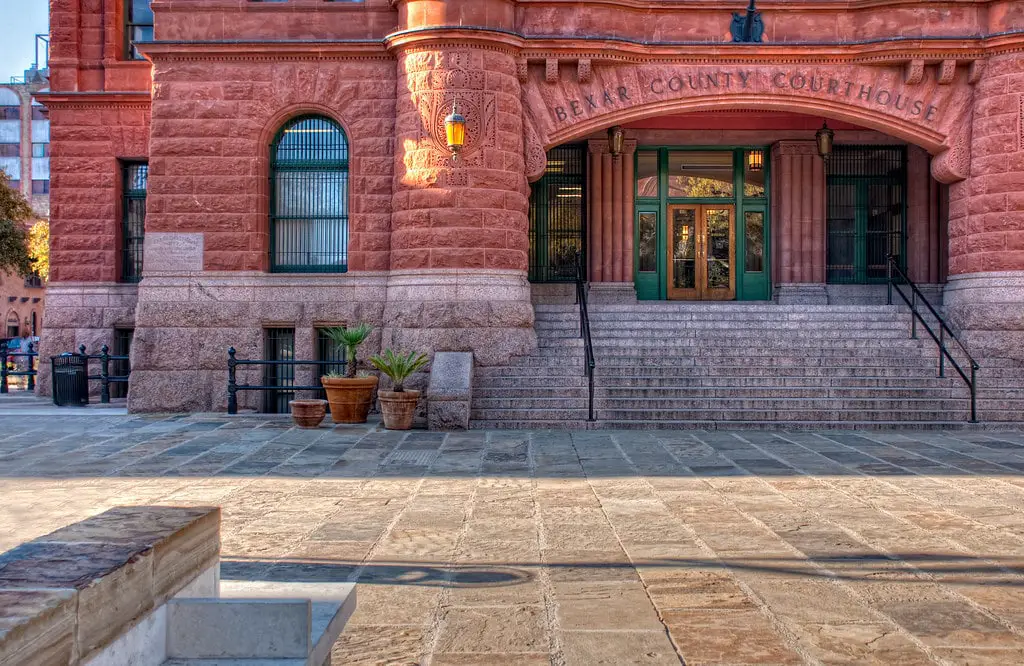A Stroll Down Memory Lane
Imagine, for a moment, strolling through downtown San Antonio, Texas, where the air is filled with this bustling city's rich history and vibrant culture. As you turn a corner, the imposing facade of the Bexar County Courthouse comes into view.
Built between 1891 and 1896, this Romanesque Revival-style building is a testament to the city's historical roots and architectural splendor.
James Riely Gordon, the mastermind behind the courthouse, was an internationally renowned architect known for his brilliant designs in the Romanesque Revival style. He had a personal affinity for San Antonio, as he had moved there as a child.

His deep connection to the city is evident in the courthouse's design, which many consider an especially magnificent example of a county courthouse.
The Bexar County Courthouse's history is rich and multilayered. This structure is the largest and most venerable courthouse in Texas with continuous operation, marking its significance as the fifth governmental headquarters in Bexar County.
Several governments and political entities ruled its predecessors, including Spain, Mexico, The Confederate States of America, The Republic of Texas, and the United States. These political changes are reflected in the courthouse's architectural layers, adding depth to its historical significance.

Architectural Marvels within the Courthouse
As you enter the courthouse, you are greeted with grandeur. The building's interior is as impressive as its exterior, boasting native Texan granite and red sandstone, roofed with distinctive green and red tiles.
Over the years, the courthouse has undergone several additions and renovations, the most significant of which occurred in 1914, 1927, 1963, and 1972. These changes added a total of 48,000 square feet to the building.
2015 a significant restoration project was undertaken to return the courthouse to its glory. This included the removal of the additions from 1963 and 1972, as well as extensive landscaping.
An ongoing effort is also being made to restore the courtrooms to their original double-height space, bringing back the grandeur of the past.

Unveiling the Past Through Art and Restoration
Peel back another layer, and you'll find a dedication to preserving and restoring the historical and artistic elements of the courthouse. In 2014, a historic finishes investigation was conducted, restoring the painted finishes of the crown molding in the courtroom.
New plaster ornament was created based on the original designs and installed in the courthouse, returning the double-height courtroom to its 1897 splendor.
The Bexar County Courthouse isn't just a functional public building and a symbol of the city's rich history. It has several historic designations, including the City of San Antonio Historic Exceptional Landmark, National Register of Historic Places, and Texas Historic Landmark.

The Courthouse Today
Fast forward to the present day, the Bexar County Courthouse is still an active part of San Antonio's urban fabric. On March 6, 2023, the courthouse reopened for in-person jury selection after a three-year hiatus due to COVID-19. Around 650 people went to the courthouse to possibly get selected for a jury, marking a significant moment in the courthouse's recent history.
Despite the changes brought about by the passage of time and the challenges of the pandemic, the Bexar County Courthouse stands as a beacon of justice and history.
Its grandeur, magnificence, and rich historical layers make it a must-visit site for anyone seeking to unravel the fascinating layers of San Antonio's past.

Bexar Heritage Center: The Heart of History
For those with a keen interest in the history of Bexar County, the Bexar Heritage Center, located within the courthouse, serves as a treasure trove of information. It's a historical center and a one-stop shop for researchers, acting as the pulsating heart of the courthouse, reverberating with the region's vibrant history.
Whether you're an amateur historian, a student working on a project, or someone who wants to know more about the roots of Bexar County, the Bexar Heritage Center can offer a wealth of knowledge.
The learning journey begins with an introduction to Bexar County's early geographical formation and evolution. Visitors can gain insights into Spain's administrative protocols and their influence in the New World, particularly in record keeping. The history of the Bexar County Courthouses, beginning with the first courthouse, Casa Reales, from the 1700s, is also narrated here.
The Heritage Center also sheds light on the county's thriving economic activity, significantly stimulated by the introduction of the railroad in 1877 and its reputation as a health destination due to its pleasant climate. The "Story Maps" section presents a timeline of Bexar County's history, from 10,000 years ago to the 1800s.
Visitors are encouraged to discover Bexar County's community involvement by exploring exhibits on art and sports venues, community arenas, cultural parks, natural habitat restorations, and innovative flood control measures.
The Bexar Heritage Center is not just a place of learning but also a hub of interactive experiences. Group tours and field trips are free, catering to various professional, educational, social, and non-profit organizations.

A Meeting Point for Past and Future
While the courthouse's architecture and design pay tribute to the past, its use as a working government building anchors it in the present.
The courthouse serves as a critical hub for the administration of justice, providing a venue for trials and other legal proceedings. It also houses various offices and departments, playing a crucial role in the governance and administration of Bexar County.
As San Antonio continues to grow and evolve, the Bexar County Courthouse will undoubtedly adapt. Yet, no matter how much the city changes, the courthouse will always be a tangible link to its past, a reminder of its rich history and cultural heritage.

